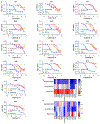Structure, function and pharmacology of human itch GPCRs
- PMID: 34789874
- PMCID: PMC9150435
- DOI: 10.1038/s41586-021-04126-6
Structure, function and pharmacology of human itch GPCRs
Abstract
The MRGPRX family of receptors (MRGPRX1-4) is a family of mas-related G-protein-coupled receptors that have evolved relatively recently1. Of these, MRGPRX2 and MRGPRX4 are key physiological and pathological mediators of itch and related mast cell-mediated hypersensitivity reactions2-5. MRGPRX2 couples to both Gi and Gq in mast cells6. Here we describe agonist-stabilized structures of MRGPRX2 coupled to Gi1 and Gq in ternary complexes with the endogenous peptide cortistatin-14 and with a synthetic agonist probe, respectively, and the development of potent antagonist probes for MRGPRX2. We also describe a specific MRGPRX4 agonist and the structure of this agonist in a complex with MRGPRX4 and Gq. Together, these findings should accelerate the structure-guided discovery of therapeutic agents for pain, itch and mast cell-mediated hypersensitivity.
© 2021. The Author(s), under exclusive licence to Springer Nature Limited.
Conflict of interest statement
Competing interests
A patent describing the MRGPRX2 antagonists has been filed by UCSF listing B.L.R., B.K.S., C.C., I.S., and H.J.K. as inventors.
Figures













Comment in
-
Scratching the itch with cryo-EM.Nat Chem Biol. 2022 Mar;18(3):242-243. doi: 10.1038/s41589-021-00959-4. Nat Chem Biol. 2022. PMID: 35046612 Free PMC article.
-
Structural insights into MRGPRX2: A new vision of itch and allergy.J Allergy Clin Immunol. 2022 Apr;149(4):1221-1222. doi: 10.1016/j.jaci.2022.01.017. Epub 2022 Jan 26. J Allergy Clin Immunol. 2022. PMID: 35090947 No abstract available.
References
Publication types
MeSH terms
Substances
Grants and funding
LinkOut - more resources
Full Text Sources
Medical
Molecular Biology Databases
Research Materials

